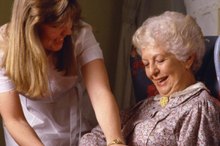How the Hospital Swing Bed Program Works
Why Swing Bed Programs Are Needed
In large part due to reduced Medicare reimbursement, many hospitals discharge patients as soon as they are no longer acutely ill. Once the patient's condition is stabilized, the hospital's discharge resource manager (typically a social worker or nurse) communicates directly with the medical team (and to a lesser extent with the family) to plan the patient's anticipated post discharge needs and appropriate placement.
With hospitals located in an urban or university setting, skilled nursing or rehab medical facilities often serve as stepping stones to home or other permanent stage care for the patient 1. However, hospitals in small rural areas may have no access to separate sub-acute facilities. Discharged patients would either have to return to home care entirely too soon or be transported to a sub-acute facility many miles from their homes. The "swing bed program" fills this void for discharged patients who still need medical care. Even some urban areas use the swing bed program because of the benefits to older and sometimes frail Medicare patients who could not handle a transport to separate facilities 1.
The Social Security Act permits certain small rural hospitals to enter a swing bed agreement. Under this agreement, the hospital can use its beds, as needed, to provide acute or skilled nursing care to the patient. As defined by federal regulations, a swing bed hospital is a hospital or critical access hospital participating in Medicare that has approval to provide post-hospital skilled care and meets certain requirements. Medicare Part A (the hospital insurance program) covers post-hospital extended care services given by a swing bed hospital.
- In large part due to reduced Medicare reimbursement, many hospitals discharge patients as soon as they are no longer acutely ill.
- Under this agreement, the hospital can use its beds, as needed, to provide acute or skilled nursing care to the patient.
Mechanics of Patient Care
Hospitalization Vs. Hospice Care
Learn More
The swing bed program is available for Medicare patients who typically underwent a relatively uncomplicated and short hospital stay. The patient remains in the same hospital and usually the same room and bed. The only change for the Medicare patient under a swing bed program is the level of care. The caregivers and medical professionals in charge of the medical care at any particular time changes (or "swings") as the patients' medical needs change.
- The swing bed program is available for Medicare patients who typically underwent a relatively uncomplicated and short hospital stay.
- The only change for the Medicare patient under a swing bed program is the level of care.
Patients' Progress
Sub-acute care focuses on care immediately following an acute condition, such as a serious illness or surgery, that required hospitalization. At the point when the patient needs only follow-up care, that patient would no longer medically need to remain in the hospital for high-tech monitoring or complex diagnostic procedures. But the patient is still a step away (hopefully) from home-based care or recovery.
The goal of the swing bed program is to return the patient to a permanent living situation as soon as possible. Although the patient under the swing bed program is in the hospital, the emphasis is on moving the patient to home or other living situation. The medical staff expects the patient to be cooperative, to take instructions and to participate in consistent rehabilitation and physical therapy activities essential to his recovery. The patient's family should feel comfortable encouraging patient participation and learning important strategies for post-discharge care.
- Sub-acute care focuses on care immediately following an acute condition, such as a serious illness or surgery, that required hospitalization.
- The goal of the swing bed program is to return the patient to a permanent living situation as soon as possible.
Benefits of the Swing Bed Program
Acute Care Vs. Chronic Care Vs. Long-Term Care
Learn More
The patient primarily benefits by fewer disruptions and continuity in care during the healing process. A Health Care Financing Administration (HCFA) evaluation in 1989 confirms the value of the swing bed program on short-stay sub-acute patients. The HCFA confirmed that the swing bed programs are intended to treat rehabilitation-oriented medical conditions, such as orthopedic injuries as opposed to chronic conditions.
Related Articles
References
- Swing Bed Providers Skilled Nursing Facilities
- Value Health Care Services. What is a Medicare Severity-Diagnosis Related Group (MS-DRG)?
- Centers for Medicare and Medicaid Services. Acute Care Hospital Inpatient Prospective Payment System.
- Centers for Medicare and Medicaid Services. Design and development of the Diagnosis Related Group (DRG). Updated October 2019.
- Centers for Medicare and Medicaid Services. Medicare Learning Network. Acute care hospital inpatient prospective payment system. Updated February 2019.
- Catalyze. Accountable care organizations (ACOs). Updated 2019.
- Field, RI. Health Care Regulation in America: Complexity, Confrontation, and Compromise. Oxford, England: Oxford University Press; 2006.
- Centers for Medicare and Medicaid Services. Hospital Readmissions Reduction Program (HRRP) And Hospital-Wide All-Cause Unplanned Readmission Measure.
- Cromwell J, Donoghue S, Gilman BH. Expansion of Medicare's definition of post-acute care transfers. Health Care Financ Rev. 2002;24(2):95–113.
- Ederhof M, Ginsburg PB. Improving Hospital Incentives with Better Cost Data. N Engl J Med. 2017;376(11):1010–1011. doi:10.1056/NEJMp1613181
Writer Bio
Cheryl Handy has more than 11 years of practical experience as an attorney with critical, professional advocacy and writing experience in health policy and medical liability law. Her life experiences provided her the opportunity to evolve that legal career into blogging and organizing events for the purpose of promoting medical patient rights, advocacy and safety.









